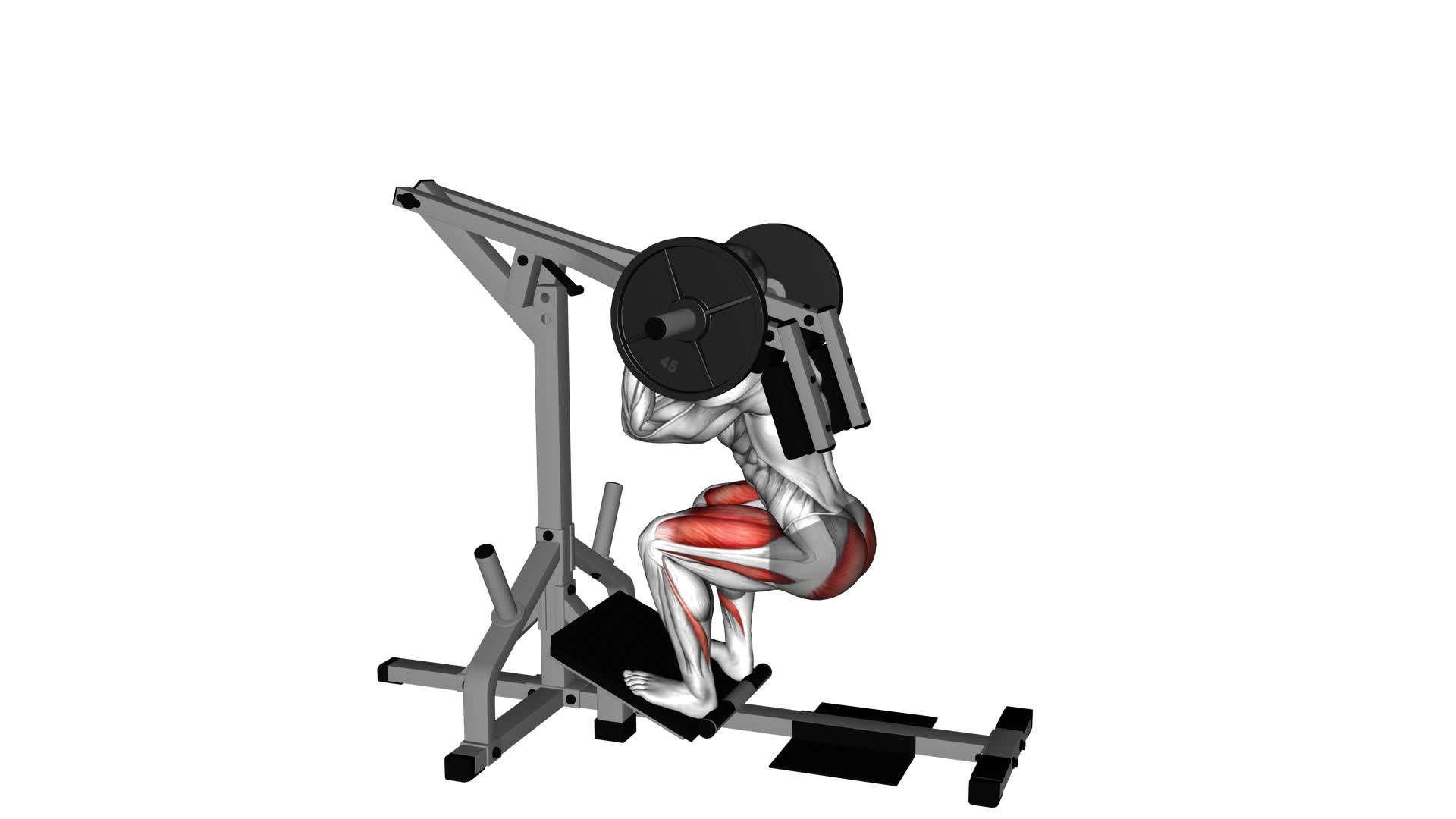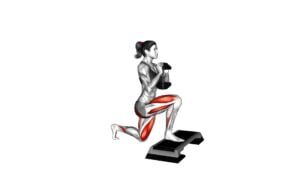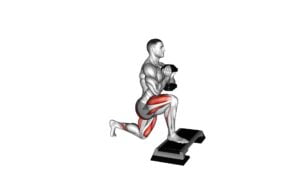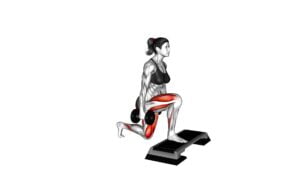Lever Elevanted Squat (male) – Video Exercise Guide & Tips

Looking to take your squat game to the next level? Check out this video exercise guide for the Lever Elevated Squat.
Watch This Exercise Video
In this guide, you'll find tips and techniques to help you maximize the benefits of this powerful lower body exercise.
Avoid common mistakes, increase intensity, and modify the workout to match your fitness level.
Plus, we'll share safety precautions and warm-up recommendations to ensure a safe and effective workout.
Get ready to elevate your squat game!
Key Takeaways
- Engages multiple muscle groups simultaneously (quadriceps, hamstrings, glutes, calves)
- Activates core muscles for overall strength and stability
- Improves balance and coordination
- Enhances proprioception for injury prevention and athletic performance
Benefits of the Lever Elevated Squat
The lever elevated squat provides a wide range of benefits for you as a male athlete or fitness enthusiast. This exercise is highly versatile, allowing for various lever elevated squat variations to target different muscle groups. One of the primary benefits of the lever elevated squat is its ability to engage multiple muscle groups simultaneously. As you perform this exercise, your quadriceps, hamstrings, glutes, and calves are all activated, helping to develop strength and power in your lower body.
In addition to targeting the lower body, the lever elevated squat also engages your core muscles. The stability required to maintain proper form during this exercise activates your abs and lower back, providing a solid foundation for overall strength and stability. This can greatly enhance your performance in other athletic activities or sports.
Another benefit of the lever elevated squat is its ability to improve balance and coordination. By performing this exercise, you not only develop strength but also enhance your proprioception, which is your body's awareness of its position in space. This can help prevent injuries and improve your overall athletic performance.
To maximize the benefits of the lever elevated squat, it's important to incorporate different variations into your workout routine. This will allow you to target specific muscle groups and avoid plateaus in your progress.
Proper Form and Technique
To achieve optimal results with the lever elevated squat, it's crucial to maintain proper form and technique throughout the exercise. Proper form not only prevents injury but also ensures that you're effectively targeting the muscles and improving balance.
Start by standing with your feet shoulder-width apart and your toes slightly turned out. Keep your back straight, chest up, and engage your core muscles. As you lower your body into the squat position, focus on pushing your hips back and bending your knees. Aim to have your thighs parallel to the ground, or as close as possible, while keeping your knees aligned with your toes.
Maintain a neutral spine throughout the exercise, avoiding any excessive rounding or arching. This will help engage your glutes, quadriceps, and hamstrings, promoting muscle activation and strength development. Remember to exhale as you push through your heels and rise back up to the starting position.
By maintaining proper form and technique, you'll maximize the benefits of the lever elevated squat, including improved balance and muscle activation.
Now, let's move on to the next section and discuss some common mistakes to avoid.
Common Mistakes to Avoid
To avoid common mistakes, make sure you aren't leaning forward or shifting your weight excessively during the lever elevated squat. Maintaining proper form is crucial for avoiding injuries and getting the most out of this exercise.
Here are some common misconceptions and mistakes to avoid:
- Leaning forward: Leaning too far forward can put excessive strain on your lower back and increase the risk of injury. Keep your chest up and maintain an upright posture throughout the movement.
- Shifting weight: Avoid shifting your weight to one side or favoring one leg over the other. This can lead to muscle imbalances and potential injuries. Make sure to distribute your weight evenly between both legs.
- Lack of control: Rushing through the exercise without proper control can compromise your form and increase the risk of injury. Focus on the slow and controlled descent, maintaining tension in your muscles throughout the movement.
- Neglecting range of motion: Ensure that you're achieving the full range of motion during the lever elevated squat. Going too shallow can limit the effectiveness of the exercise, while going too deep can put unnecessary stress on your joints.
Tips for Increasing Intensity
To increase the intensity of your lever elevated squats, you can incorporate progressive overload techniques and advanced training methods.
Progressive overload involves gradually increasing the weight or resistance used during your workouts to continuously challenge your muscles.
Advanced training methods, such as drop sets or supersets, can also help to increase the intensity by pushing your muscles to work harder and fatigue more quickly.
Progressive Overload Techniques
To increase the intensity of your workouts, incorporate progressive overload techniques into your training routine. These techniques involve gradually increasing the demands on your muscles and body over time. Here are four effective progressive overload techniques to help you take your workouts to the next level:
- Increase the weight: Gradually increase the amount of weight you lift to challenge your muscles and promote strength gains.
- Add more reps or sets: Increase the number of repetitions or sets you perform to push your muscles further and increase endurance.
- Decrease rest time: Shorten the rest periods between sets to keep your heart rate elevated and improve cardiovascular fitness.
- Change exercise tempo: Slow down the eccentric (lowering) phase of your lifts to increase time under tension and stimulate muscle growth.
Advanced Training Methods
Increase the intensity of your workouts by incorporating advanced training methods. One way to do this is by incorporating advanced variations of exercises into your routine. Instead of sticking to traditional squats, try the lever elevated squat, which targets your lower body muscles in a more challenging way.
Another strategy is to implement different training strategies, such as drop sets or supersets. Drop sets involve performing a set of an exercise, then immediately reducing the weight and performing another set without rest. Supersets involve performing two exercises back-to-back without rest.
These advanced training methods can help you break through plateaus and continue making progress in your fitness journey. Remember to always listen to your body and progress at a pace that's challenging but sustainable for you.
Modifications for Different Fitness Levels
You can modify the lever elevated squat exercise based on your fitness level. Here are some modifications you can make to suit your needs:
- Beginner modifications: If you're new to this exercise or have limited strength and mobility, you can start by using a lower lever or step to elevate your heels. This will reduce the range of motion and make it easier to perform the squat. Additionally, you can use a lighter weight or no weight at all until you build up your strength.
- Advanced modifications: For those who are more experienced and looking for an extra challenge, you can increase the height of the lever or step to further engage your muscles. You can also try adding weight by holding a dumbbell or kettlebell at your chest or using a barbell on your back. This will intensify the exercise and help you build more strength and muscle.
By modifying the lever elevated squat exercise according to your fitness level, you can ensure that you're working within your capabilities and making progress towards your goals. Remember to always listen to your body and make adjustments as needed.
Now that you know how to modify the exercise, let's move on to the next section about safety precautions and warm-up recommendations.
Safety Precautions and Warm-up Recommendations
Before starting any exercise, it's important to prioritize stretching for injury prevention.
Additionally, maintaining proper form throughout the lever elevated squat is crucial for avoiding strain or injury.
Remember to start with a manageable intensity and gradually increase the difficulty to ensure a safe and effective workout.
Stretching for Injury Prevention
To prevent injuries during your workout, prioritize stretching as a crucial part of your warm-up routine. Incorporating dynamic stretching and foam rolling can help prepare your muscles and joints for the physical demands of exercise. Here are four important reasons why you should include stretching in your warm-up:
- Increased flexibility: Dynamic stretching helps improve your range of motion, allowing you to move more efficiently and reducing the risk of muscle strains or tears.
- Enhanced circulation: Stretching increases blood flow to your muscles, delivering oxygen and nutrients while removing waste products. This can help prevent muscle fatigue and improve performance.
- Injury prevention: By properly warming up and stretching, you can identify any muscle imbalances or tightness that may increase the risk of injury during your workout. Addressing these issues early on can help prevent future injuries.
- Mental preparation: Stretching not only prepares your body but also your mind for the upcoming workout. It allows you to focus, increase your body awareness, and mentally prepare for the physical challenges ahead.
Importance of Proper Form
After prioritizing stretching for injury prevention, it's important to understand the importance of proper form, including safety precautions and warm-up recommendations.
Proper form is crucial for maximizing the benefits of any exercise and minimizing the risk of injury. By maintaining proper alignment and technique, you can target the intended muscles more effectively and avoid unnecessary strain on joints and ligaments. Common form mistakes, such as rounding the back or using momentum to lift weights, can lead to muscle imbalances, strains, and even serious injuries.
To ensure safety, it's recommended to start with a proper warm-up that includes dynamic stretches and light cardiovascular exercises. This prepares your body for the upcoming workout and reduces the risk of muscle pulls or strains.
With a solid understanding of proper form and safety precautions, you can now progress to the next section on gradual intensity progression.
Gradual Intensity Progression
Start by gradually increasing the intensity of your workouts while taking safety precautions and incorporating warm-up exercises. This will help you avoid injuries and maximize your workout potential. Here are some important tips to keep in mind:
- Listen to your body: Pay attention to any discomfort or pain during your workouts. If something doesn't feel right, modify the exercise or decrease the resistance.
- Start with lighter weights: When increasing resistance, start with lighter weights and gradually work your way up. This allows your muscles to adapt and prevents strain.
- Proper form: Maintain proper form throughout your exercises. This not only maximizes the effectiveness of the workout but also reduces the risk of injury.
- Warm-up exercises: Always include a warm-up routine before starting your workout. This prepares your muscles for the upcoming intensity and helps prevent muscle strains.
Frequently Asked Questions
How Many Sets and Reps Should I Do for the Lever Elevated Squat Exercise?
To determine the number of sets and reps for the lever elevated squat exercise, it's important to consider your fitness goals and current fitness level. Generally, it's recommended to start with 3-4 sets of 8-12 reps.
This will help improve lower body strength, stability, and muscle endurance. As you progress, you can increase the number of sets and reps.
Lever elevated squats target your quadriceps, glutes, and hamstrings, providing a challenging full-body workout.
Can I Perform the Lever Elevated Squat Exercise With Dumbbells or Kettlebells Instead of a Barbell?
Yes, you can definitely perform the lever elevated squat exercise with dumbbells or kettlebells instead of a barbell. This substitution can provide several benefits, such as improved stability and increased activation of your core muscles.
Is It Necessary to Use an Elevated Platform for the Lever Elevated Squat, or Can I Perform It on the Ground?
Yes, you can perform the lever elevated squat on the ground instead of using an elevated platform. However, using an elevated platform offers variations and benefits to the exercise.
The elevated platform allows for a greater range of motion and increased activation of the glutes and hamstrings. It also helps with balance and stability.
Can the Lever Elevated Squat Help Improve My Vertical Jump?
The lever elevated squat can definitely help improve your vertical jump. By incorporating vertical jump training techniques, such as explosive movements and increased lower body strength, the lever elevated squat can enhance your ability to jump higher.
This exercise specifically targets your quads, hamstrings, and glutes, which are all key muscle groups for generating power in your legs. The added challenge of the elevated platform further intensifies the workout, providing even more benefits for your vertical jump.
How Long Should I Rest Between Sets When Performing the Lever Elevated Squat Exercise?
When performing the lever elevated squat exercise, it's important to consider the rest duration between sets. Resting for around 1 to 2 minutes between sets can allow your muscles to recover and regain energy for the next set. This rest period helps to prevent fatigue and maintain proper form throughout the exercise.
Additionally, the lever elevated squat offers benefits such as strengthening the lower body and improving stability.
Conclusion
In conclusion, the lever elevated squat is a highly effective exercise for building strength and muscle in the lower body. By maintaining proper form and avoiding common mistakes, you can maximize the benefits of this exercise.
Additionally, incorporating modifications and gradually increasing intensity can help challenge different fitness levels. Remember to prioritize safety by following precautions and warming up before performing this exercise.
Start incorporating the lever elevated squat into your workout routine for improved lower body strength and overall fitness.

Author
Years ago, the spark of my life’s passion ignited in my mind the moment I stepped into the local gym for the first time. The inaugural bead of perspiration, the initial endeavor, the very first surge of endorphins, and a sense of pride that washed over me post-workout marked the beginning of my deep-seated interest in strength sports, fitness, and sports nutrition. This very curiosity blossomed rapidly into a profound fascination, propelling me to earn a Master’s degree in Physical Education from the Academy of Physical Education in Krakow, followed by a Sports Manager diploma from the Jagiellonian University. My journey of growth led me to gain more specialized qualifications, such as being a certified personal trainer with a focus on sports dietetics, a lifeguard, and an instructor for wellness and corrective gymnastics. Theoretical knowledge paired seamlessly with practical experience, reinforcing my belief that the transformation of individuals under my guidance was also a reflection of my personal growth. This belief holds true even today. Each day, I strive to push the boundaries and explore new realms. These realms gently elevate me to greater heights. The unique combination of passion for my field and the continuous quest for growth fuels my drive to break new ground.







